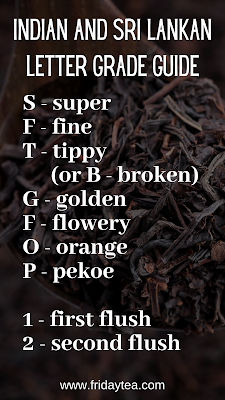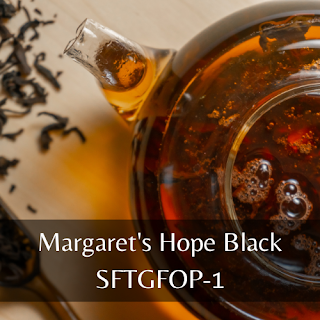
"Yes, I'd like two ounces of the Darjeeling...sfff...tug..fop?"
We hear your attempts at pronouncing this alphanumeric stew every day at the tea house, and who can blame you? When an estate or region name is followed by a gibberish string of letters and numbers and you have no idea what they mean but remember your grandmother pouring you delicious steaming cups of fine Indian black tea and just want to recreate the experience for some nostalgia and comfort, dang it? Worry not, my dear. I've got you covered. Let's talk tea grades!
The mysterious collection of letters and numbers on your Indian and Sri Lankan tea labels is a code and I am here to help you crack it. This is a simple leaf grading system created by our brilliant and hard working South Asian tea appraisers, and understanding what each letter means can give you a hint as to what flavor you are about to enjoy!
First things first: the more letters, the higher the grade. If you like a full-bodied, astringent cuppa that's great to sink milk and sugar into, aim low on the alphanumerics. If you prefer floral, light-bodied and complex teas, aim for as many letters as you can find.
Let's break down the code:
S is for Super or Special and is only applied to a leaf of the highest quality. The youngest picks, the most complex layered flavor, the most ephemeral sensory experience. The fancy shit.
F is for Fine (sometimes Finest), or for Flowery. It depends on where we are in the acronym. If it's a long strand and your F sits beside an S or a T, it's Fine(st). Finest refers to a quality just north of mid-range, but not quite the highest quality for the market's standards. These are complex and flavorful, but may not be the absolute most delicate and smooth.
T is for Tippy and B is for Broken, which each indicate a leaf style. Tippy refers to a whole leaf (visible tip and base on the same leaf), while Broken refers to a leaf that has been cut or torn (raw, ragged edges with either tip, base or neither present on a given bit of leaf).
G is for Golden, which indicates a higher ratio of tippy to lower pick. This letter means you can count on a good ratio of floral, smooth notes to robust, earthy and astringent notes.
OP is for Orange Pekoe. These two go together and refer to the base grade of quality required to qualify for grading in the first place. The "orange" here refers to the color of the brew. South India is famous for their OP, having popularized the style and to this day hold the highest international awards in this category. They’re not the only ones in the game, however. Sri Lanka has been showing off for the past decade or so in the OP department and produces some truly exemplary options!
- 1 is for First Flush, the first pick of the season. These are the buds with the most complexity, the most delicacy, and the most caffeine. Very prized!
- 2 is for Second Flush, the second pick of the season. A bit more brash, a bit more edge, a bit lower on the caffeine content. Still quite excellent! Farms don’t bother to track numbers after this point, so you’ll not see any -3, -4, -5, etc.
And that's all there is to it! I hope you found some helpful knowledge here and feel empowered to go boldly (or tippily) forth on your tea shopping adventures, armed with the information you need to purchase fine tea and actually understand what the heck-dang all those letters and numbers even mean.
If I may suggest a place to start? We're currently swooning over these two SFTGFOP-1 Darjeelings: Margaret's Hope Estate Black and Makaibari Estate Green!
xoxo,
Friday


Comments
Post a Comment